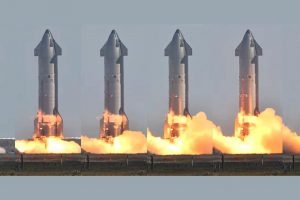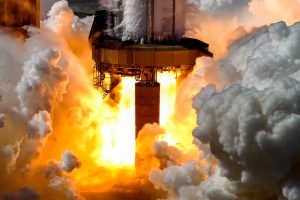In a new Q&A with the Federal Communications Commission (FCC), SpaceX says it still “plans” and “intends” to begin launching the next generation of Starlink satellites as early as March 2022.
In August 2021, SpaceX filed an application modification request with the FCC in a bid to change its plans for the next-generation “Gen2” Starlink constellation, which still aims to drastically improve and expand upon its first few phases. SpaceX filed the first unmodified Gen2 Starlink application with the FCC in May 2020, requesting permission to launch an unprecedented 30,000 satellites. While the size of the proposed constellation is extraordinary, the FCC has also been exceptionally slow to process it. Only five months after SpaceX submitted its Starlink Gen2 modification request and nineteen months after its original Gen2 application did the FCC finally accept it for filing, which means that it has taken more than a year and a half to merely start the official review process.
That extremely slow pace of work could pose problems for SpaceX’s characteristically ambitious deployment schedule.
In a January 7th, 2022 electronic filing in which SpaceX answered a dozen questions from the FCC, the company didn’t outright criticize the extreme sluggishness with which it was reviewing the application but the sentiment was still just below the surface throughout it. After noting that the FCC continues to ask for far more information from SpaceX than it does from other constellation applications, some of which have recently received licenses in spite of that, SpaceX states that it while it “filed its Gen2 Application more than nineteen months ago…and its Amendment nearly five months ago, they were accepted for filing only two weeks ago.”
It’s perhaps no coincidence that that inexplicable delay only came to an end two weeks after FCC Chairwoman Jessica Rosenworcel – who SpaceX notes recently acknowledged a “need to speed the processing of applications to keep pace with…innovation” – was finally confirmed by the US Senate.
Most importantly, though, SpaceX used its extensive Q&A to reveal that it downselected to one of the two similar constellation configurations proposed in its Gen2 application modification. Specifically, SpaceX says it will continue to develop Configuration 1 only, which is designed and organized to take full advantage of the company’s next-generation Starship launch vehicle. That should simplify the licensing process for many Starlink competitors, which have sought to hobble SpaceX’s application with bizarre requests to the FCC and complained ad nauseam about how much of a burden analyzing two potentially constellation layouts was for them. Now they will only have to consider one constellation layout, making SpaceX’s Gen2 constellation a more traditional – if still massive – proposal.
Clearly lacking a great deal of self-awareness about the irony of such of a question, the FCC also saw fit to ask SpaceX for “any updates regarding the expected timing of launches for the Gen2 system.” The timing of Starlink Gen2 launches is obviously unequivocally contingent upon FCC approval more than 19 months after SpaceX first submitted an application for said approval. Nonetheless, SpaceX politely answered the question, revealing that it had “informed Commission staff before filing its Amendment” in August 2021 that it “plans to have Gen2 satellites prepared for launch as soon as March 2022” and “still intends to begin launching [Starlink Gen2 satellites] as early as March 2022.”
Many readers and industry followers interpreted this as an implicit claim that Starship will be ready to launch Starlink Gen2 satellites as early as March 2022 – just another of the company’s detached-from-reality schedule estimates, in other words. That’s simply not the case, though. While SpaceX does confirm that it’s settling on a Starlink Gen2 configuration that will explicitly depend upon Starship for the full 29,988-satellite constellation’s timely, cost-effective deployment, FCC deployment and operations licensing are almost inherently unconcerned with how the constellation gets into space. For example, the original Gen2 application SpaceX modified last August never mentioned which launch vehicle would be responsible for launching tens of thousands of satellites. So long as the rocket is compliant with FCC regulations and has an active permit for any given launch, which is also the responsibility of a different bureau, the FCC is effectively indifferent about which rockets launch a given constellation.
In other words, while SpaceX has made it clear that Starlink Gen2 Configuration 1 is optimized for Starship, SpaceX will be free to launch Gen2 satellites on any rocket it wants if or when the FCC approves the constellation. Assuming that Starlink Gen2 satellites will still be able to fit inside a 5.2m (17 ft) wide payload fairing, that includes Falcon 9. Further, in early 2018, the FCC allowed SpaceX to launch the first two Starlink satellite prototypes before it had issued the company a license for the full constellation, making it clear that prospective constellation operators can launch and test prototype satellites before their full constellations are approved.
This is to say that there is nothing theoretically preventing SpaceX from again pursuing permission to launch a few prototype Starlink satellites (this time Gen2) before the FCC has finished reviewing and approving the whole constellation. In fact, anything less would actually be surprising and unusual for the company. When SpaceX says in January 2022 that it plans to have Gen2 satellites ready for launch by March 2022, it’s thus not hard to believe that that’s the truth. Perhaps it will take a month or two longer than planned to complete the prototypes, secure temporary FCC approval, and build and license a new E-band ground station, but it’s still believable that SpaceX will be ready and able to launch the first few Starlink Gen2 satellites on Falcon 9 within the next several months. Above all else, unless SpaceX has explicitly designed Starlink Gen2 satellites such that they no longer fit inside a Falcon fairing, nothing is forcing SpaceX to wait for Starship if Gen2 prototypes are ready to launch before the next-gen rocket.
Given that Starship will have to wait until at least March 2022 for its first orbital test flight after FAA review delays, it’s obviously implausible that the rocket will be ready to launch Starlink prototypes by then. Starship S20 – currently said by CEO Elon Musk to be the first space-bound prototype – doesn’t even have a payload bay. Unless SpaceX wants to wait several more months after that to kick off the flight-testing phase of Starlink Gen2 development, it’s likely that the first few satellites will launch on Falcon 9 – either alongside routine Starlink V1.5 launches or on their own.





